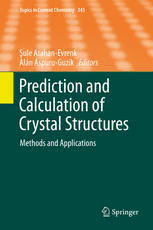Table Of ContentTopics in Current Chemistry 345
Şule Atahan-Evrenk
Alán Aspuru-Guzik Editors
Prediction and
Calculation of
Crystal Structures
Methods and Applications
345
Topics in Current Chemistry
EditorialBoard:
K.N.Houk,LosAngeles,CA,USA
C.A.Hunter,Sheffield,UK
M.J.Krische,Austin,TX,USA
J.-M.Lehn,Strasbourg,France
S.V.Ley,Cambridge,UK
M.Olivucci,Siena,Italy
J.Thiem,Hamburg,Germany
M.Venturi,Bologna,Italy
C.-H.Wong,Taipei,Taiwan
H.N.C.Wong,Shatin,HongKong
Forfurthervolumes:
http://www.springer.com/series/128
Aims and Scope
TheseriesTopicsinCurrentChemistry presentscriticalreviews ofthepresent and
futuretrendsinmodernchemicalresearch.Thescopeofcoverageincludesallareasof
chemical science including the interfaces with related disciplines such as biology,
medicineandmaterialsscience.
Thegoalofeachthematicvolumeistogivethenon-specialistreader,whetherat
theuniversityorinindustry,acomprehensiveoverviewofanareawherenewinsights
areemergingthatareofinteresttolargerscientificaudience.
Thuseachreviewwithinthevolumecriticallysurveysoneaspectofthattopicand
placesitwithinthecontextofthevolumeasawhole.Themostsignificantdevelop-
mentsofthelast5to10yearsshouldbepresented.Adescriptionofthelaboratory
procedures involved is often useful to the reader. The coverage should not be
exhaustiveindata,butshouldratherbeconceptual,concentratingonthemethodolog-
icalthinkingthatwill allowthenon-specialistreaderto understandtheinformation
presented.
Discussionofpossiblefutureresearchdirectionsintheareaiswelcome.
Reviewarticlesfortheindividualvolumesareinvitedbythevolumeeditors.
Readership:researchchemistsatuniversitiesorinindustry,graduatestudents.
Şule Atahan-Evrenk Alán Aspuru-Guzik
l
Editors
Prediction and Calculation
of Crystal Structures
Methods and Applications
With contributions by
(cid:1) (cid:1) (cid:1)
C.S. Adjiman A. Aspuru-Guzik S. Atahan-Evrenk
(cid:1) (cid:1) (cid:1) (cid:1)
G.J.O. Beran J.G. Brandenburg S. Grimme G. Hautier
(cid:1) (cid:1) (cid:1) (cid:1)
Y. Heit R.G. Hennig Y. Huang A.V. Kazantsev
(cid:1) (cid:1) (cid:1) (cid:1)
K. Nanda A.R. Oganov C.C. Pantelides B.C. Revard
(cid:1) (cid:1) (cid:1) (cid:1)
R.Q. Snurr W.W. Tipton S. Wen C.E. Wilmer
(cid:1)
X.-F. Zhou Q. Zhu
Editors
S¸uleAtahan-Evrenk
Ala´nAspuru-Guzik
Dept.ofChemistryandChemicalBiology
HarvardUniversity
Cambridge
Massachusetts
USA
ISSN0340-1022 ISSN1436-5049(electronic)
ISBN978-3-319-05773-6 ISBN978-3-319-05774-3(eBook)
DOI10.1007/978-3-319-05774-3
SpringerChamHeidelbergNewYorkDordrechtLondon
LibraryofCongressControlNumber:2014938743
#SpringerInternationalPublishingSwitzerland2014
Thisworkissubjecttocopyright.AllrightsarereservedbythePublisher,whetherthewholeorpartof
the material is concerned, specifically the rights of translation, reprinting, reuse of illustrations,
recitation,broadcasting,reproductiononmicrofilmsorinanyotherphysicalway,andtransmissionor
informationstorageandretrieval,electronicadaptation,computersoftware,orbysimilarordissimilar
methodologynowknownorhereafterdeveloped.Exemptedfromthislegalreservationarebriefexcerpts
inconnectionwithreviewsorscholarlyanalysisormaterialsuppliedspecificallyforthepurposeofbeing
enteredandexecutedonacomputersystem,forexclusiveusebythepurchaserofthework.Duplication
ofthispublicationorpartsthereofispermittedonlyundertheprovisionsoftheCopyrightLawofthe
Publisher’s location, in its current version, and permission for use must always be obtained from
Springer.PermissionsforusemaybeobtainedthroughRightsLinkattheCopyrightClearanceCenter.
ViolationsareliabletoprosecutionundertherespectiveCopyrightLaw.
The use of general descriptive names, registered names, trademarks, service marks, etc. in this
publicationdoesnotimply,evenintheabsenceofaspecificstatement,thatsuchnamesareexempt
fromtherelevantprotectivelawsandregulationsandthereforefreeforgeneraluse.
While the advice and information in this book are believed to be true and accurate at the date of
publication,neithertheauthorsnortheeditorsnorthepublishercanacceptanylegalresponsibilityfor
anyerrorsoromissionsthatmaybemade.Thepublishermakesnowarranty,expressorimplied,with
respecttothematerialcontainedherein.
Printedonacid-freepaper
SpringerispartofSpringerScience+BusinessMedia(www.springer.com)
Preface
Thepredictionofcrystalstructureforachemicalcompoundisstillachallenge.It
requiresadvancedalgorithmsforexhaustivesearchesofthepossiblepackingforms
and highly accurate computational methodologies to rank the possible crystal
structures. This book presents some of the important developments in crystal
structurepredictioninrecentyears.Thechaptersdonotcovereveryareabutrather
presentawiderangeofmethodologieswithapplicationsinorganic,inorganic,and
hybridcompounds.
The blind tests organized by the Cambridge Crystallographic Data Center
(CCDC) showed a notable improvement for the crystal structure prediction of
organic compounds over recent years. The first two chapters of this book present
two of the methodologies contributed to the success in recent blind tests. The
chapter “Dispersion Corrected Hartree–Fock and Density Functional Theory for
OrganicCrystalStructurePrediction”byBrandenburgandGrimmeisdedicatedto
recent advances in the dispersion-corrected Hartree–Fock and density functional
theory. Another important areashowingremarkableprogressistheefficienttreat-
mentoftheinternalflexibilityofmoleculeswithmanyrotatablebonds.Thechapter
“GeneralComputational Algorithms forAbInitioCrystalStructure Prediction for
Organic Molecules” by Pantelides et al. summarizes some of the algorithms that
have contributed to this success. In addition, the chapter “Accurate and Robust
Molecular Crystal Predictions Using Fragment-Based Electronic Structure Meth-
ods” by Beran et al. illustrates how fragment-based electronic structure methods
canprovideaccuratepredictionofthelatticeenergydifferencesofpolymorphsof
organiccompounds.
One research area that would benefit tremendously from the crystal structure
prediction of organic compounds is the design of organic semiconductors. In the
chapter “Prediction and Theoretical Characterization of Organic Semiconductor
Crystals for Field-Effect Transistor Applications” by S¸ule Atahan-Evrenk and
Ala´n Aspuru-Guzik, discuss some aspects of theoretical characterization and pre-
dictionofcrystalstructuresofp-typeorganicsemiconductorsfororganictransistor
applications. The chapter also provides information about the structure–property
relationshipsinorganicsemiconductors.
v
vi Preface
In organic systems, thanks to the internal constraints of molecular structures,
randomsamplingmethodscanbeusedsuccessfully.Ininorganiccrystals,however,
there are no constraints other than the chemical compositions. Therefore, the
challenge in the crystal structure prediction of inorganic compounds is the search
problem,andthemethodologiesthatspanthesearchspaceeffectivelyarecrucial.
ThechaptersbyHautier,byRevardetal.,andbyZhuetal.arededicatedtocover
recentadvancestowardsachievinginorganiccrystalprediction.Thechapter“Data
MiningApproachestoHigh-ThroughputCrystalStructureandCompoundPredic-
tion”byHautierdiscussesdataminingapproachesandthechaptersbyRevardetal.
and by Zhu et al. cover evolutionary algorithms for compound prediction. In
particular, the chapter “Structure and Stability Prediction of Compounds with
Evolutionary Algorithms” by Revard et al. presents different methodologies
adaptedfortheevolutionaryalgorithmsapproachesandthechapter“CrystalStruc-
turePredictionandItsApplicationinEarthandMaterialsSciences”byZhuaetal.
focusesonthestateoftheartoftheUSPEXmethodology.
The prediction of hybrid materials such as metal-organic frameworks posits a
specificsetofchallengesforstructureprediction.Thechapter“Large-ScaleGener-
ation and Screening of Hypothetical Metal-Organic Frameworks for Applications
in Gas Storage and Separation” by Wilmer and Snurr discusses the large-scale
generationandscreeningofmetal-organicframeworks.Withpossibleapplications
in storage, catalysis, pharmaceuticals, and electrochemistry, these methodologies
showgreatpotentialfordevelopmentofhybridsystems.
Webelievecrystalstructurepredictionwillbeoneofthemostimportanttoolsin
solid-statechemistryinthenearfuture.Applicationsrangingfrompharmaceuticals
toenergytechnologieswouldbenefittremendouslyfromcomputationalprediction
ofthesolidformsofmaterials.Webelievethisbookprovidesup-to-date,concise,
andaccessiblecoverageofthesubjectforawideaudienceinacademiaandindustry
andwehopethatitwillbeusefulforchemistsandmaterialsscientistswhowantto
learn more about the state-of-the-art in crystal structure prediction methods and
applications.
WewouldliketothankSpringereditorsBirkeDaliaandElizabethHawkinsfor
invitingustoeditthisvolumeandalltheauthorsfortheircontributions.Lastly,we
would like to thank all the members of the Aspuru-Guzik Group for their support
andcamaraderie.
Cambridge,MA,USA S¸uleAtahan-EvrenkandAla´nAspuru-Guzik
December2013
Contents
DispersionCorrectedHartree–FockandDensityFunctionalTheory
forOrganicCrystalStructurePrediction .................................... 1
JanGeritBrandenburgandStefanGrimme
GeneralComputationalAlgorithmsforAbInitioCrystalStructure
PredictionforOrganicMolecules ............................................ 25
ConstantinosC.Pantelides,ClaireS.Adjiman,andAndreiV.Kazantsev
AccurateandRobustMolecularCrystalModelingUsingFragment-Based
ElectronicStructureMethods ................................................ 59
GregoryJ.O.Beran,ShuhaoWen,KaushikNanda,YuanhangHuang,
andYonatonHeit
PredictionandTheoreticalCharacterizationofp-TypeOrganic
SemiconductorCrystalsforField-EffectTransistorApplications ........ 95
S¸uleAtahan-EvrenkandAla´nAspuru-Guzik
DataMiningApproachestoHigh-ThroughputCrystalStructure
andCompoundPrediction ................................................... 139
GeoffroyHautier
StructureandStabilityPredictionofCompoundswithEvolutionary
Algorithms .................................................................... 181
BenjaminC.Revard,WilliamW.Tipton,andRichardG.Hennig
CrystalStructurePredictionandItsApplicationinEarthandMaterials
Sciences ....................................................................... 223
QiangZhu,ArtemR.Oganov,andXiang-FengZhou
vii
viii Contents
Large-ScaleGenerationandScreeningofHypotheticalMetal-Organic
FrameworksforApplicationsinGasStorageandSeparations .......... 257
ChristopherE.WilmerandRandallQ.Snurr
Index .......................................................................... 291
TopCurrChem(2014)345:1–24
DOI:10.1007/128_2013_488
#Springer-VerlagBerlinHeidelberg2013
Publishedonline:13November2013
Dispersion Corrected Hartree–Fock and
Density Functional Theory for Organic
Crystal Structure Prediction
JanGeritBrandenburgandStefanGrimme
Abstract We present and evaluate dispersion corrected Hartree–Fock (HF) and
Density Functional Theory (DFT) based quantum chemical methods for organic
crystal structure prediction. The necessity of correcting for missing long-range
electroncorrelation,alsoknownasvanderWaals(vdW)interaction,ispointedout
andsomemethodologicalissuessuchasinclusionofthree-bodydispersiontermsare
discussed. One of the most efficient and widely used methods is the semi-classical
dispersioncorrectionD3.Itsapplicabilityforthecalculationofsublimationenergies
isinvestigatedforthebenchmarksetX23consistingof23smallorganiccrystals.For
PBE-D3 the mean absolute deviation (MAD) is below the estimated experimental
uncertainty of 1.3 kcal/mol. For two larger π-systems, the equilibrium crystal
geometryisinvestigatedandverygoodagreementwithexperimentaldataisfound.
Since these calculations are carried out with huge plane-wave basis sets they are
rathertimeconsumingandroutinelyapplicableonlytosystemswithlessthanabout
200 atoms in the unit cell. Aiming at crystal structure prediction, which involves
screeningofmanystructures,apre-sortingwithfastermethodsismandatory.Small,
atom-centered basis setscan speed upthe computation significantlybut theysuffer
greatlyfrombasisseterrors.Wepresenttherecentlydevelopedgeometricalcounter-
poisecorrectiongCP.Itisafastsemi-empiricalmethodwhichcorrectsformostof
theinter-andintramolecularbasissetsuperpositionerror.ForHFcalculationswith
nearlyminimalbasissets,weadditionallycorrectforshort-rangebasisincomplete-
ness.WecombineallthreetermsintheHF-3cdenotedschemewhichperformsvery
wellfortheX23sublimationenergieswithanMADofonly1.5kcal/mol,whichis
closetothehugebasissetDFT-D3result.
Keywords Counterpoise correction (cid:1) Crystal structure prediction (cid:1) Density
FunctionalTheory(cid:1)Dispersioncorrection(cid:1)Hartree–Fock
J.G.BrandenburgandS.Grimme(*)
MullikenCenterforTheoreticalChemistry,Institutfu¨rPhysikalischeundTheoretische
ChemiederUniversita¨tBonn,Beringstraße4,53115Bonn,Germany
e-mail:[email protected];[email protected]

